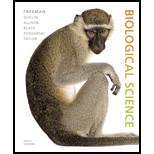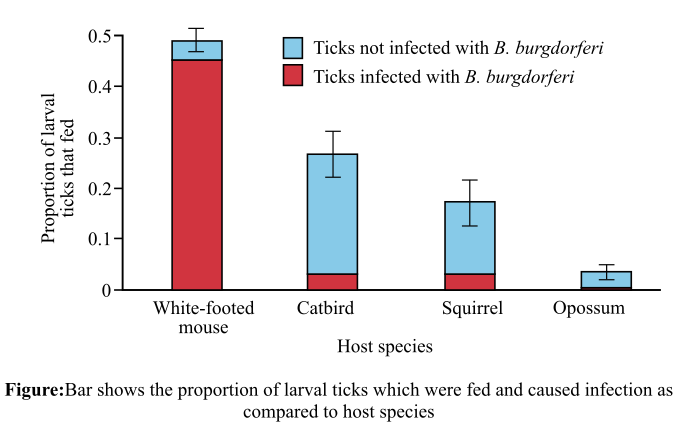
Concept explainers
To review:
Based on the graph’s data, the percentage of ticks on mice that were infected with Borrelia burgdorferi (B. burgdorferi) and the percentage of ticks on opossums that were groomed off and killed.
Introduction:
B. burgdorferi is the bacterium that is transferred into the body of humans by the ticks. It is an endoparasite that lives inside the human body and causes Lyme disease. The newly hatched ticks do not harbor B. burgdorferi bacterium as they are killed by the host when they crawl onto the host organism, and if they are successful in harvesting the blood from their host, then they are generally not infected by B. burgdorferi. A bar diagram showing the proportion of larval ticks that fed and caused infection versus host species is given below:

Want to see the full answer?
Check out a sample textbook solution
Chapter 52 Solutions
Biological Science (6th Edition)
- Describe the symbiosis between the Riftia tubeworm and its bacterial symbiont. What is the role of the Riftia tube worm hemoglobin in the success of its relationship with the symbiotic bacteria?arrow_forwardMalaria Where did the disease originate? What impact did it have on the individuals living in the effected areas? How was the disease spread? How did individuals combat the disease? What reforms were initiated after the event? Your research must contain one location in the U.S. or Colonial America that experienced an outbreak.arrow_forwardFor question with blank, choose the combination of answers that most accurately completes the statement.The .................. host is where the larva develops, and the host is where the adults produce fertile eggs. a. intermediate, defi nitive c. secondary, transport b. defi nitive, intermediate d. primary, secondaryarrow_forward
- Give typing answer with explanation and conclusion . Which of the following statement is INCORRECT? A. Zoonotic diseases are diseases transmitted from animals to humans B. One source of antibiotic-resistance genes is the original antibiotic-producing organisms themselves. C. Nosocomial diseases are diseases one acquires while staying in a healthcare facility. D. A virus with a high LD50 is likely to spread rapidly and become pandemic.arrow_forwardIn your own words discuss the statement "Mass Deaths of Marine Mammals spur Veterinary Microbiology".arrow_forwardwrite a sentence outline and an essay.In what ways are pandemics and endemics similar and in what ways/way are they different?arrow_forward
- With the help of a well – labelled diagram, Describe the life cycle of malarial parasite.arrow_forwardcreate and graphical abstract of The microbiota regulate neuronal function and fear extinction learningarrow_forwardGive typing answer with explanation and conclusion to all parts Antibiotics selectively inhibit or kill bacterial cells. Describe three targets of antibiotics in bacterial cells. Explain how the antibiotics produce these effects at each target. Bacteria have evolved mechanisms of resistance to many antibiotics. Describe two different mechanisms of resistance, explaining how the bacterium overcomes the action of the antibiotic. Give an example of an antibiotic whose effect can be overcome by each of the mechanisms you have described.arrow_forward
- Using the video from https://www.pbs.org/video/natures-cutest-symbiosis-the-bobtail-squid-4bhtmo/ The bobtail squid and Vibrio fischeri serve as model organisms for studying cellular communication. Provideat least two examples of communication either between squid and bacteria or within bacteria from the film.arrow_forwardiWhich one of the following statements BEST describes insects as biological vectors of disease? Insects in which the disease......Select one: a. develops and/or multiplies, and disease is transmitted by biting b.multiplies, and disease is transmitted by biting or by piercing and sucking c. develops and/or multiplies d. develops and/or multiplies, and disease is transmitted by piercing and sucking e. develops, and disease is transmitted by biting or by piercing and sucking ii Which of the following best describes the way that insects exploit a cadaver a. there is strong competition between species for the resource b. there is strong competition within species for the resource c. there is a gradual change over time as one species replaces another d. there is a gradual gain and loss of species over time as one set of species replaces another e. one species dominates the cadaverarrow_forwardName a thing which is not a parasitic adaptation.arrow_forward
